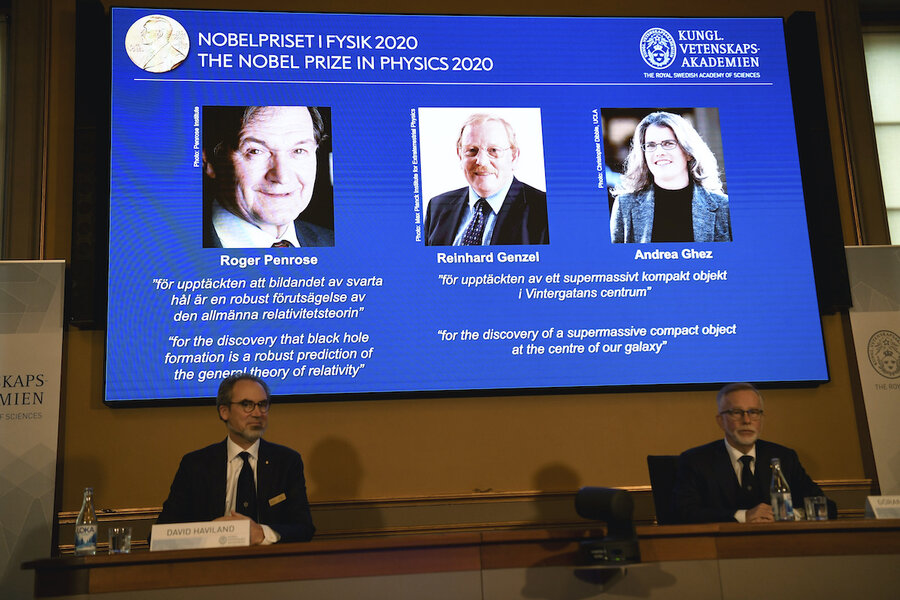Nobel Prize in physics celebrates mysteries of black holes
Loading...
| Stockholm
Three scientists won this year’s Nobel Prize in physics Tuesday for advancing our understanding of black holes, the all-consuming monsters that lurk in the darkest parts of the universe.
Briton Roger Penrose received half of this year’s prize “for the discovery that black hole formation is a robust prediction of the general theory of relativity,” the Nobel Committee said.
German Reinhard Genzel and American Andrea Ghez received the second half of the prize “for the discovery of a supermassive compact object at the center of our galaxy.”
The prize celebrates “one of the most exotic objects in the universe,” black holes, which have become a staple of science fact and science fiction and where time seems to stand still, according to the committee.
Black holes are perhaps the most mysterious and powerful objects in astronomy. They are at the center of every galaxy, and smaller ones are dotted around the universe. Nothing, not even light, can escape their incredible gravity. They are the ultimate cosmic dead end.
“Black holes, because they are so hard to understand, is what makes them so appealing,’’ Dr. Ghez told The Associated Press Tuesday morning. “I really think of science as a big, giant puzzle.”
Dr. Penrose proved with mathematics that the formation of black holes was possible, based heavily on Albert Einstein’s general theory of relativity.
“Einstein did not himself believe that black holes really exist, these super-heavyweight monsters that capture everything that enters them,” the committee said. “Nothing can escape, not even light.”
Martin Rees, the British astronomer royal, noted that Dr. Penrose triggered a “renaissance” in the study of relativity in the 1960s, and that, together with a young Stephen Hawking, he helped firm up evidence for the Big Bang and black holes.
“Penrose and Hawking are the two individuals who have done more than anyone else since Einstein to deepen our knowledge of gravity,” Dr. Rees said. “Sadly, this award was too much delayed to allow Hawking to share the credit.”
Dr. Hawking died in 2018, and Nobel prizes are only awarded to living scientists.
It wasn’t until the 1990s that Dr. Genzel and Dr. Ghez, each leading a group of astronomers, trained their sights on the dust-covered center of our Milky Way galaxy, a region called Sagittarius A*, where something strange was going on.
They both found that there was “an extremely heavy, invisible object that pulls on the jumble of stars, causing them to rush around at dizzying speeds.”
It was a black hole. Not just an ordinary black hole, but a supermassive black hole, 4 million times the mass of our sun.
Now scientists know that all galaxies have supermassive black holes.
In 2019, scientists got the first optical image of a black hole, and Dr. Ghez, who was not involved, praised the discovery.
“Today we accept these objects are critical to the building blocks of the universe,” Dr. Ghez told an audience at the Royal Swedish Academy of Sciences by phone shortly after the announcement.
Dr. Ghez is the fourth woman to be awarded the Nobel Prize for physics, after Marie Curie in 1903, Maria Goeppert-Mayer in 1963, and Donna Strickland in 2018.
“I hope I can inspire other young women into the field. It’s a field that has so many pleasures. And if you’re passionate about the science, there’s so much that can be done,” Dr. Ghez said.
The Nobel Committee said black holes “still pose many questions that beg for answers and motivate future research.”
It is common for several scientists who worked in related fields to share the prize. Last year’s prize went to Canadian-born cosmologist James Peebles for theoretical work about the early moments after the Big Bang, and Swiss astronomers Michel Mayor and Didier Queloz for discovering a planet outside our solar system.
The prestigious award comes with a gold medal and prize money of $1.1 million, courtesy of a bequest left 124 years ago by the prize’s creator, Swedish inventor Alfred Nobel. The amount was increased recently to adjust for inflation.
On Monday, the Nobel Committee awarded the prize for physiology and medicine to Americans Harvey J. Alter and Charles M. Rice and British-born scientist Michael Houghton for discovering the liver-ravaging hepatitis C virus.
“Great science is often a group of people," said Dr. Houghton n a press conference."Going forward, we somehow need to incorporate that.”
The other prizes, to be announced in the coming days, are for outstanding work in the fields of chemistry, literature, peace, and economics.
This story was reported by The Associated Press. Seth Borenstein reported from Kensington, Maryland. AP writer Frank Jordans in Berlin contributed to this report.







